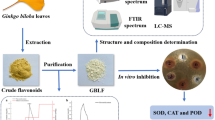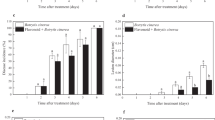Abstract
Rhizopus nigricans (R. nigricans), one of the fungi that grows the fastest, is frequently discovered in postharvest fruits, it’s the main pathogen of strawberry root rot. Flavonoids in Sedum aizoon L. (FSAL) is a kind of green and safe natural substance extracted from Sedum aizoon L. which has antifungal activity. In this study, the minimum inhibitory concentration (MIC) of FSAL on R. nigricans and cell apoptosis tests were studied to explore the inhibitory effect of FSAL on R. nigricans. The effects of FSAL on mitochondria of R. nigricans were investigated through the changes of mitochondrial permeability transition pore(mPTP), mitochondrial membrane potential(MMP), Ca2+ content, H2O2 content, cytochrome c (Cyt c) content, the related enzyme activity and related genes of mitochondria. The results showed that the MIC of FSAL on R. nigricans was 1.800 mg/mL, with the addition of FSAL (1.800 mg/mL), the mPTP openness of R. nigricans increased and the MMP reduced. Resulting in an increase in Ca2+ content, accumulation of H2O2 content and decrease of Cyt c content, the activity of related enzymes was inhibited and related genes were up-regulated (VDAC1, ANT) or down-regulated (SDHA, NOX2). This suggests that FSAL may achieve the inhibitory effect of fungi by damaging mitochondria, thereby realizing the postharvest freshness preservation of strawberries. This lays the foundation for the development of a new plant-derived antimicrobial agent.










Similar content being viewed by others
Data availability
Data will be made available on request.
References
Abied MAE, Khalil MLL, Awad MF, Youssef SA (2023) Alleviation of black root rot symptoms and alteration of strawberry growth via modulating physiological and biochemical mechanisms using Trichoderma viride and Bacillus subtilis. Eur J Plant Pathol 167:235–250. https://doi.org/10.1007/s10658-023-02697-w
Fang Z, Xu L, Lin Y, Cai X, Wang S (2019) The preservative potential of Octopus scraps peptides – zinc chelate against Staphylococcus aureus: its fabrication, antibacterial activity and action mode. Food Control 98:24–33. https://doi.org/10.1016/j.foodcont.2018.11.015
Frank JC (2019) Mitochondrial function and abnormalities implicated in the pathogenesis of ASD. Prog Neuro Psychoph 92:83–108. https://doi.org/10.1016/j.pnpbp.2018.12.015
Ganeshpurkar A, Saluja AK (2019) The pharmacological potential of Rutin. Saudi Pharm J 25(2):149–164. https://doi.org/10.1016/j.jsps.2016.04.025
Hu Y, Zhang J, Kong W, Zhao G, Yang M (2017) Mechanisms of antifungal and anti-aflatoxigenic properties of essential oil derived from turmeric (Curcuma longa L.) on aspergillus flavus. Food Chem 220:1–8. https://doi.org/10.1016/j.foodchem.2016.09.179
Kadenbach B, Arnold S, Lee L, Hüttemann M (2004) The possible role of cytochrome c oxidase in stress-induced apoptosis and degenerative diseases. Biochim Biophys Acta 1655(1–3):400–408. https://doi.org/10.1016/j.bbabio.2003.06.005
Kim S, Woo ER, Lee DG (2020) Apigenin promotes antibacterial activity via regulation of nitric oxide and superoxide anion production. J Basic Microbiol 60(10):862–872. https://doi.org/10.1002/jobm.202000432
Kwun MS, Lee DG (2020) Quercetin-induced yeast apoptosis through mitochondrial dysfunction under the accumulation of magnesium in Candida albicans [J]. Fungal Biology 124(2). https://doi.org/10.1016/j.funbio.2019.11.009
Lennicke C, Rahn J, Lichtenfels R, Wessjohann LA, Seliger B (2015) Hydrogen peroxide - production, fate and role in redox signaling of tumor cells. Cell Commun Signal 13:39. https://doi.org/10.1186/s12964-015-0118-6
Li A-P, He Y-H, Zhang S-Y, ShiY-P (2022) Antibacterial activity and action mechanism of flavonoids against phytopathogenic bacteria. Pestic Biochem Physiol 188. https://doi.org/10.1016/j.pestbp.2022.105221
Liu G, Wang Z, Wang Z, Yang D, Liu Z, Wang L (2016) Mitochondrial permeability transition and its regulatory components are implicated in apoptosis of primary cultures of rat proximal tubular cells exposed to lead. Arch Toxicol 90(5):1193–1209. https://doi.org/10.1007/s00204-015-1547-0
Luo J, Xu F, Zhang X, Shao X, Wei Y, Wang H (2020) Transcriptome analysis of Penicillium Italicum in response to the flavonoids from Sedum aizoon L. World J Microb Biot 36(5). https://doi.org/10.1007/s11274-020-02836-z
Ma W, Zhao L, Johnson ET, Xie Y, Zhang M (2022) Natural food flavour (E)-2-hexenal, a potential antifungal agent, induces mitochondria-mediated apoptosis in aspergillus flavus conidia via a ROS-dependent pathway. Int J Food Microbiol 370:109633. https://doi.org/10.1016/j.ijfoodmicro.2022.109633
Madeo F, Herker E, Wissing S, Jungwirth H, Eisenberg T, Fröhlich KU (2004) Apoptosis in yeast. Curr Opin Microbiol 7(6):655–660. https://doi.org/10.1016/j.mib.2004.10.012
Mao X, Emma W, Matilde C, Toh S, Searle S, Ramachandran S, Lacroix Y, Ahmed M, Rutter AR (2018) Probing mitochondrial permeability transition pore activity in nucleated cells and platelets by high-throughput screening assays suggests involvement of protein phosphatase 2B in mitochondrial dynamics. Assay Drug Dev Technol 16(8):445–455. https://doi.org/10.1089/adt.2018.872
Marchi S, Giorgi C, Suski JM et al (2012) Mitochondria-Ros crosstalk in the control of cell death and aging. J Signal Transduct 2012:329635. https://doi.org/10.1155/2012/329635
Maria LA, Laerte F, Aleksandro ADS et al (2016) Participation of purines in the modulation of inflammatory response in rats experimentally infected by Cryptococcus neoformans. Microb Pathog 99:36–40. https://doi.org/10.1016/j.micpath.2016.07.015
Naeem A, Yang M, Hu P, Kang YJ, Liu Y, Xiao S, Li W, Wu L, Zhang M, Liu S, Zheng Q (2022) The fate of flavonoids after oral administration: a comprehensive overview of its bioavailability. Crit Rev Food Sci Nutr 62(22):6169–6186. https://doi.org/10.1080/10408398.2021.1898333
Nunes CA (2011) Biological control of postharvest diseases of fruit. Eur J Plant Pathol 133(1):181–196. https://doi.org/10.1007/s10658-011-9919-7
Oztekin S, Dikmetas DN, Devecioglu D, Acar EG, Guler FK (2023) Recent insights into the use of antagonistic yeasts for sustainable biomanagement of Postharvest pathogenic and mycotoxigenic Fungi in fruits with their Prevention strategies against mycotoxins. J Agric Food Chem 71(26):9923–9950. https://doi.org/10.1021/acs.jafc.3c00315
Pang C, Chen J, Liu S, Cao Y, Miao H (2023) In vitro antifungal activity of Shikonin against Candida albicans by inducing cellular apoptosis and necrosis. Mol Biol Rep 50(2):1079–1087. https://doi.org/10.1007/s11033-022-08093-7
Schein SJ, Colombini M, Finkelstein A (1976) Reconstitution in Planar Lipid Bilayers of aVoltage-Dependent Anion-Selective Channel Obtained from Paramecium Mitochondria. https://doi.org/J. Membrane Biol. 30, 99–120 (1976)
Seo DJ, Jeon SB, Oh H, Lee BH, Lee SY, Oh S, Jung J, Choi C (2016) Comparison of the antiviral activity of flavonoids against murine norovirus and feline calicivirus. Food Control 60:25–30. https://doi.org/10.1016/j.foodcont.2015.07.023
Shoshan-Barmatz V, Keinan N, Abu-Hamad S, Tyomkin D, Aram L (2010) Apoptosis is regulated by the VDAC1 N-terminal region and by VDAC oligomerization: release of cytochrome c, AIF and Smac/Diablo. Biochim Biophys Acta 1797(6–7):1281–1291. https://doi.org/10.1016/j.bbabio.2010.03.003
Wang J, Chi Z, Zhao K, Wang H, Zhang X, Xu F, Shao X, Wei Y (2020) A transcriptome analysis of the antibacterial mechanism of flavonoids from Sedum aizoon L. against Shewanella putrefaciens. World J Microbiol Biotechnol 36. https://doi.org/10.1007/s11274-020-02871-w
Wang K, Zhang X, Shao X, Wei Y, Xu F, Wang H (2022) Flavonoids from Sedum aizoon L. inhibit Botrytis Cinerea by negatively affecting cell membrane lipid metabolism. Appl Microbiol Biotechnol 106(21):7139–7151. https://doi.org/10.1007/s00253-022-12196-3
Wang K, Ge Q, Shao X, Wei Y, Zhang X, Wang H, Xu F (2023) The antifungal efficacy of flavonoids from Sedum aizoon L. on grapes. https://doi.org/10.1007/s11947-023-03165-3. Food Bioprocess Tech
Xu T, Wang Z, Lei T, Chongning L, Wang J, Lu J (2015) New flavonoid glycosides from Sedum aizoon L. Fitoterapia 101:125–132. https://doi.org/10.1016/j.fitote.2014.12.014
Xu F, Cao S, W C, W Y,S X WK, W H (2019) Antimicrobial activity of flavonoids from Sedum aizoon L. against Aeromonas in culture medium and in frozen pork. Food Sci Nutr 7:3224–3232. https://doi.org/10.1002/fsn3.1178
Zhang Q, Zhang M, Wang Y, Zhen T, Wang R, Wang S, Du Y, Yu R, Yi P, Song Y, Zhi Y, Song X, Guo Y, He Z, Chen Tie, Li C (2022) Natural compound 2-Chloro-1,3-dimethoxy-5-methylbenzene, isolated from Hericium Erinaceus, inhibits fungal growth by disrupting membranes and triggering apoptosis. J Agric Food Chem 70(21):6444–6454. https://doi.org/10.1021/acs.jafc.2c01417
Zhao L, Deng X, Li Y, Hu J, Xie L, Shi F, Tang M, Bode AM, Zhang X, Liao W, Cao Y (2021) Conformational change of adenine nucleotide translocase-1 mediates cisplatin resistance induced by EBV-LMP1. EMBO Mol Med 13(12):e14072. https://doi.org/10.15252/emmm.202114072
Zhao L, He F, Li B, Gu X, Zhang X, DhanasekaranS, Zhang H (2022) Transcriptomic analysis of the mechanisms involved in enhanced antagonistic efficacy of Meyerozyma guilliermondii by methyl jasmonate and disease resistance of postharvest apples. Lwt 160. https://doi.org/10.1016/j.lwt.2022.113323
Zheng S, Jing G, Wang X, Ouyang Q, Jia L, Tao N (2015) Citral exerts its antifungal activity against Penicillium digitatum by affecting the mitochondrial morphology and function. Food Chem 178:76–81. https://doi.org/10.1016/j.foodchem.2015.01.077
Zheng Y, Zhan Q, Shi T, Liu J, Zhao K, Gao Y (2020) The nuclear transporter SAD2 plays a role in calcium- and H2O2 -mediated cell death in Arabidopsis. Plant J 101(2):324–333. https://doi.org/10.1111/tpj.14544
Zou X, Wei Y, Zhu J, Sun J, Shao X (2023) Volatile Organic compounds of Scheffersomyces spartinae W9 have Antifungal Effect against Botrytis Cinerea on Strawberry Fruit. Foods 12(19). https://doi.org/10.3390/foods12193619
Acknowledgements
This study was supported by Natural Science Foundation of Zhejiang Province [LY16C200003],. We thank Key Laboratory of Animal Protein Food Processing Technology of Zhejiang Province.
Author information
Authors and Affiliations
Contributions
QG: Methodology, Investigation, Writing - Original Draft. SZ: Investigation, Writing - Original Draft. XS: Writing - Review & Editing. YW: Data Curation. JC: Validation, Formal analysis. HW: Conceptualization, Supervision, Project administration. FX: Resources, Investigation.
Corresponding authors
Ethics declarations
Competing interests
The authors declare no competing interests.
Additional information
Publisher’s Note
Springer Nature remains neutral with regard to jurisdictional claims in published maps and institutional affiliations.
Rights and permissions
Springer Nature or its licensor (e.g. a society or other partner) holds exclusive rights to this article under a publishing agreement with the author(s) or other rightsholder(s); author self-archiving of the accepted manuscript version of this article is solely governed by the terms of such publishing agreement and applicable law.
About this article
Cite this article
Ge, Q., Zhao, S., Shao, X. et al. Influence of flavonoids from Sedum aizoon L. on mitochondrial function of Rhizopus nigricans in strawberry. World J Microbiol Biotechnol 40, 161 (2024). https://doi.org/10.1007/s11274-024-03967-3
Received:
Accepted:
Published:
DOI: https://doi.org/10.1007/s11274-024-03967-3




